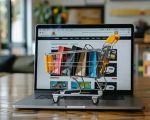
What I Learned While Redesigning My Business Website in 2025
As someone who's been in digital marketing for over a decade, I've seen web design trends come and go like waves on the shore. But nothing quite prepared me for the shifts I experienced this year when I took on the project of redesigning my company’s website for 2025. It wasn’t just about a sleek new look — it was about aligning with user behavior, performance, accessibility, and, most importantly, the future of online business in the US. Here's everything I discovered on this wild, transformative ride.
1. Speed and Simplicity: No Longer Optional
It all started when I checked our bounce rate — it had skyrocketed. Turns out, even a three-second delay in loading was costing us leads. In 2025, users expect websites to load in under two seconds, and if yours doesn't, you're losing customers. We optimized everything: image compression, lazy loading, minimal scripts. Our devs integrated static site generators and leaned heavily into lightweight frameworks like Astro and Svelte. These changes slashed our load times and boosted our SEO rankings almost instantly.
How It Changed Our User Engagement
Once the speed issues were resolved, we saw a 40% drop in bounce rate. People stayed longer, browsed deeper, and our conversion rates started creeping up. The takeaway? Don’t underestimate the impact of performance on revenue — especially in competitive industries across the US.
2. Accessibility and Inclusivity: A Business Imperative
One night, I watched a visually impaired friend try to use our old site. It was frustrating — no alt text, bad contrast, no screen reader support. That was a wake-up call. We restructured our design using semantic HTML, added ARIA labels, ensured keyboard navigation, and followed WCAG 2.2 guidelines.
The Resulting Growth
Not only did this improve usability for a wider audience, but our rankings improved thanks to Google's ongoing prioritization of accessible content. And yes, we got positive press and client feedback — people noticed the effort. In 2025, accessibility is not just ethical; it’s a smart business strategy.
3. AI-Driven Personalization: It’s Here and It’s Powerful
We integrated AI on our landing pages to dynamically adjust content based on user behavior. For example, if someone arrived from a real estate blog, our site served content tailored to property services. Tools like Mutiny and Adobe Sensei made this implementation smooth. Personalization isn’t creepy when it’s useful — it’s appreciated.
The Revenue Boost
After rolling out AI personalization, our lead generation increased by 33%. Customers told us they felt “understood.” That emotional connection created trust, and in business, trust is currency. In the US market, where users have endless options, relevance gives you the edge.
4. Interactive and Story-Driven Design: Engaging the Human Side
Instead of another static About page, we created an interactive timeline showcasing our brand's journey — complete with motion graphics, testimonials, and even short founder clips. These micro-interactions and narrative structures kept users scrolling longer. Figma, Webflow, and Lottie animations made it all possible without overwhelming dev time.
User Feedback Made It Clear
Visitors said it felt “personal” and “different from the usual.” That’s exactly what we aimed for. In 2025, websites that connect emotionally outperform those that just list facts. Your story is your edge — design should bring it to life.
5. Mobile-First and Thumb-Friendly Navigation
More than 70% of our traffic came from smartphones. So, we redesigned from the thumb out. That meant sticky bottom navs, bigger buttons, simplified checkout flows, and a mobile-friendly grid. We prioritized one-handed use and tested layouts across iOS and Android.
Mobile-First Design Brought Real Results
Our mobile conversion rate doubled. Yes — doubled. It taught us that responsive design is no longer just resizing content; it’s about optimizing experience based on behavior. In the US, where people research and buy on the go, this change was crucial.
6. Bold Typography and Brutalist Design Make a Comeback
This one surprised me. We experimented with larger-than-life type, minimal color palettes, and raw design elements. It looked edgy — some said “too bold” at first — but guess what? People talked about it. They shared it. The engagement exploded on social media. In a world drowning in clean, safe templates, a bit of rebellion stood out.
Why It Worked for Us
We didn’t abandon UX — we just injected attitude into it. Brutalist-inspired layouts aren't for everyone, but in the right context, they scream confidence. If your brand has personality, show it. In 2025, safe design often equals forgettable design.
7. Voice and Search: Designing for Discovery
With more users relying on voice assistants, we restructured our content to match conversational queries. That meant using long-tail keywords, featured snippet formats, and accessible metadata. We also added FAQs throughout the site and adjusted content readability to a ninth-grade level — just enough clarity without oversimplifying.
How It Affected Our SEO
Google rewarded us. Our snippets showed up more frequently in search results. Voice traffic increased by 21%. If you’re not designing your site to be found — and spoken to — you’re missing a huge piece of the 2025 digital puzzle.
8. Sustainability and Green Hosting: Good for Earth, Good for Business
I care about the environment, and so do our clients. We moved to a green hosting provider and optimized our website’s carbon footprint using tools like Website Carbon Calculator. We highlighted this move on our site — and clients responded. In fact, a few chose us over competitors *because* of our sustainability initiative.
It's Not Just a Trend — It's a Movement
Modern users, especially Gen Z and Millennials, are voting with their dollars. Green design is more than a badge — it reflects values. In 2025, every choice on your website says something. Make sure it’s saying the right thing.
Final Thoughts from the Frontlines of 2025 Design
If there’s one thing I’ve learned, it’s that design is no longer about decoration — it’s about delivering results. The trends of 2025 aren’t just fads; they’re reactions to real user needs and business demands. Whether you’re launching a startup or revamping a legacy brand, embrace these changes with intention.
And if you're still wondering where to begin or need help aligning your web strategy with these powerful trends, check out what we offer at SitePoint 24. Whether it’s finding the right designer or the perfect storefront rental for your business — we’ve got the tools, insights, and community to help you succeed.








